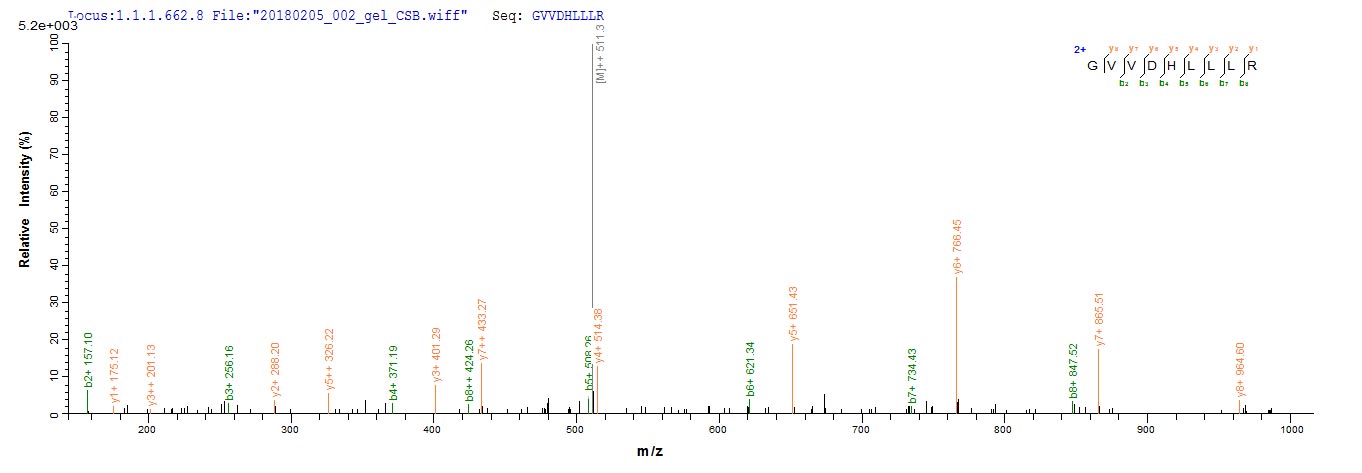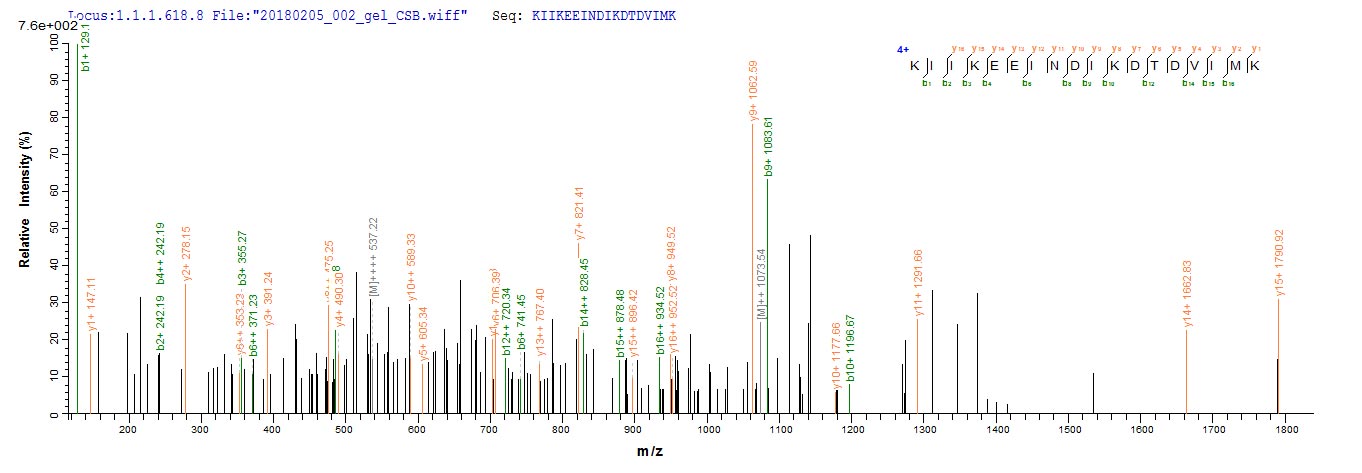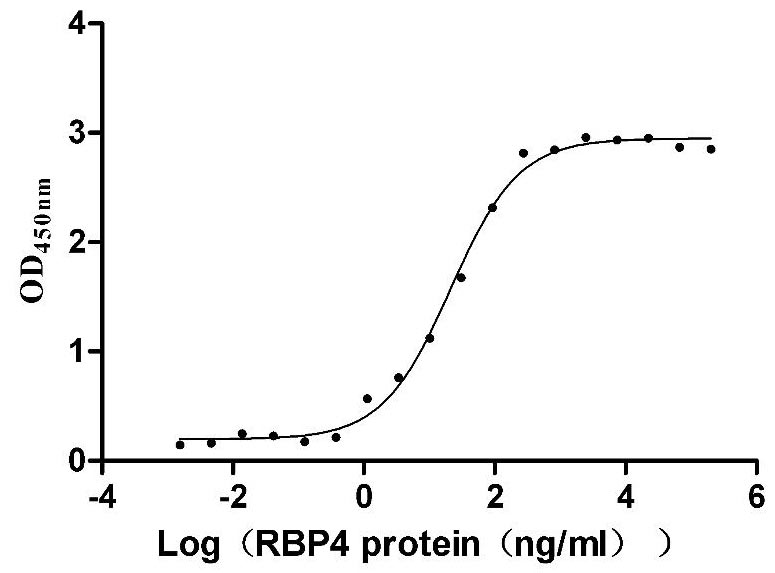Recombinant Human Cyclic GMP-AMP synthase (CGAS), partial
In Stock-
中文名称:Recombinant Human Cyclic GMP-AMP synthase(CGAS),partial
-
货号:CSB-EP822726HU
-
规格:¥1344
-
图片:
-
(Tris-Glycine gel) Discontinuous SDS-PAGE (reduced) with 5% enrichment gel and 15% separation gel.
-
Based on the SEQUEST from database of E.coli host and target protein, the LC-MS/MS Analysis result of CSB-EP822726HU could indicate that this peptide derived from E.coli-expressed Homo sapiens (Human) MB21D1.
-
Based on the SEQUEST from database of E.coli host and target protein, the LC-MS/MS Analysis result of CSB-EP822726HU could indicate that this peptide derived from E.coli-expressed Homo sapiens (Human) MB21D1.
-
-
其他:
产品详情
-
纯度:Greater than 90% as determined by SDS-PAGE.
-
基因名:CGAS
-
Uniprot No.:
-
别名:C6orf150; cGAMP synthase; cGAS; CGAS_HUMAN; cGMP Synthase; Chromosome 6 open reading frame 150; Cyclic GMP-AMP synthase; h-cGAS; Hypothetical protein LOC115004; Mab 21 domain containing 1; Mab-21 domain-containing protein 1; MB21D1; MGC131892; MGC142166; MGC142168; OTTHUMP00000016743; OTTHUMP00000039330; protein MB21D1; Uncharacterized protein C6orf150
-
种属:Homo sapiens (Human)
-
蛋白长度:Partial
-
来源:E.coli
-
分子量:58.3kDa
-
表达区域:161-522aa
-
氨基酸序列GASKLRAVLEKLKLSRDDISTAAGMVKGVVDHLLLRLKCDSAFRGVGLLNTGSYYEHVKISAPNEFDVMFKLEVPRIQLEEYSNTRAYYFVKFKRNPKENPLSQFLEGEILSASKMLSKFRKIIKEEINDIKDTDVIMKRKRGGSPAVTLLISEKISVDITLALESKSSWPASTQEGLRIQNWLSAKVRKQLRLKPFYLVPKHAKEGNGFQEETWRLSFSHIEKEILNNHGKSKTCCENKEEKCCRKDCLKLMKYLLEQLKERFKDKKHLDKFSSYHVKTAFFHVCTQNPQDSQWDRKDLGLCFDNCVTYFLQCLRTEKLENYFIPEFNLFSSNLIDKRSKEFLTKQIEYERNNEFPVFDEF
Note: The complete sequence including tag sequence, target protein sequence and linker sequence could be provided upon request. -
蛋白标签:N-terminal 6xHis-SUMO-tagged
-
产品提供形式:Liquid or Lyophilized powder
Note: We will preferentially ship the format that we have in stock, however, if you have any special requirement for the format, please remark your requirement when placing the order, we will prepare according to your demand. -
缓冲液:Tris-based buffer,50% glycerol
-
储存条件:Store at -20°C/-80°C upon receipt, aliquoting is necessary for mutiple use. Avoid repeated freeze-thaw cycles.
-
保质期:The shelf life is related to many factors, storage state, buffer ingredients, storage temperature and the stability of the protein itself.
Generally, the shelf life of liquid form is 6 months at -20°C/-80°C. The shelf life of lyophilized form is 12 months at -20°C/-80°C. -
货期:3-7 business days
-
注意事项:Repeated freezing and thawing is not recommended. Store working aliquots at 4°C for up to one week.
-
产品描述:
The recombinant 6xHis-SUMO-tagged cyclic GMP-AMP synthase (CGAS) protein was expressed in E.coli. Amino acid residues Gly161-Phe522 of human CGAS protein are contained in this recombinant protein. The SDS-PAGE measured its purity of over 90%, and the CGAS protein migrated to the molecular mass of about 50-61 kDa on the gel. And It was also validated by the LC-MS/MS analysis. In addition to generating specific anti-CGAS antibodies, this recombinant CGAS protein may be also used in the studies of the CGAS-STING signaling pathway.
CGAS is an enzyme that synthesizes second messenger GAMP, which is activated upon binding of CGAS to DNA or RNA-DNA hybrids in the cytoplasm. As a DNA damage sensor, CGAS detects pathogenic DNA to trigger an innate immune reaction involving a strong type I interferon response against microbial infections through the CGAS-STING signaling pathway. CGAS also plays a major role in modulating autophagy. It is involved in cancer, diabetes, and immune disorders. Manish Sharma etc. demonstrated that CGAS is up-regulated in Huntington disease (HD) and mediates inflammatory and autophagy responses and suggested that the CGAS pathway may be the therapeutic target for HD.
-
Datasheet & COA:Please contact us to get it.
相关产品
靶点详情
-
功能:Nucleotidyltransferase that catalyzes the formation of cyclic GMP-AMP (cGAMP) from ATP and GTP and plays a key role in innate immunity. Catalysis involves both the formation of a 2',5' phosphodiester linkage at the GpA step and the formation of a 3',5' phosphodiester linkage at the ApG step, producing c[G(2',5')pA(3',5')p]. Acts as a key cytosolic DNA sensor, the presence of double-stranded DNA (dsDNA) in the cytoplasm being a danger signal that triggers the immune responses. Binds cytosolic DNA directly, leading to activation and synthesis of cGAMP, a second messenger that binds to and activates TMEM173/STING, thereby triggering type-I interferon production. Preferentially recognizes and binds curved long DNAs. In contrast to other mammals, human CGAS displays species-specific mechanisms of DNA recognition and produces less cyclic GMP-AMP (cGAMP), allowing a more fine-tuned response to pathogens. Has antiviral activity by sensing the presence of dsDNA from DNA viruses in the cytoplasm. Also acts as an innate immune sensor of infection by retroviruses, such as HIV-1, by detecting the presence of reverse-transcribed DNA in the cytosol. Detection of retroviral reverse-transcribed DNA in the cytosol may be indirect and be mediated via interaction with PQBP1, which directly binds reverse-transcribed retroviral DNA. Also detects the presence of DNA from bacteria, such as M.tuberculosis. cGAMP can be transferred from producing cells to neighboring cells through gap junctions, leading to promote TMEM173/STING activation and convey immune response to connecting cells. cGAMP can also be transferred between cells by virtue of packaging within viral particles contributing to IFN-induction in newly infected cells in a cGAS-independent but TMEM173/STING-dependent manner. In addition to antiviral activity, also involved in the response to cellular stresses, such as senescence, DNA damage or genome instability. Acts as a regulator of cellular senescence by binding to cytosolic chromatin fragments that are present in senescent cells, leading to trigger type-I interferon production via TMEM173/STING and promote cellular senescence. Also involved in the inflammatory response to genome instability and double-stranded DNA breaks: acts by localizing to micronuclei arising from genome instability. Micronuclei, which as frequently found in cancer cells, consist of chromatin surrounded by its own nuclear membrane: following breakdown of the micronuclear envelope, a process associated with chromothripsis, CGAS binds self-DNA exposed to the cytosol, leading to cGAMP synthesis and subsequent activation of TMEM173/STING and type-I interferon production. Acts as a suppressor of DNA repair in response to DNA damage: translocates to the nucleus following dephosphorylation at Tyr-215 and inhibits homologous recombination repair by interacting with PARP1, the CGAS-PARP1 interaction leading to impede the formation of the PARP1-TIMELESS complex.
-
基因功能参考文献:
- STAG2 deficiency induces interferon responses via cGAS-STING pathway and restricts virus infection. PMID: 29662124
- Data show that both cyclic GMP-AMP synthase (cGAS) and interferon-gamma inducible protein 16 (IFI16) are required for the activation of membrane protein STING (STING) and an innate immune response to exogenous DNA and DNA viruses. PMID: 28194029
- duration of LVAD support negatively correlated with expression differences of PKG I, PDE5, and sGC in ICM, but not in DCM. Originating from the same activation level at LVAD implantation, cardiac unloading significantly alters key components of the cGMP-PKG pathway in DCM, but not in ICM patients. PMID: 29546540
- cGAS and STING mediated detection of pneumococcal DNA in mouse macrophages to primarily stimulate type I interferon responses. PMID: 29263110
- These results demonstrated that the DNA-induced phase transition of cGAS promotes cGAMP production and innate immune signaling. PMID: 29976794
- Thus, the intracellular level of TREX1 pivotally modulates innate immune induction by HIV-1. Partial HIV-1 genomes are the TREX1 target and are sensed by cGAS. PMID: 29769349
- This study demonstrated that HSV-1 tegument protein VP22 counteracts the cGAS/STING-mediated DNA-sensing antiviral innate immunity signaling pathway by inhibiting the enzymatic activity of cGAS. PMID: 29793952
- study reports that the DENV NS2B protease cofactor targets the DNA sensor cyclic GMP-AMP synthase (cGAS) for lysosomal degradation to avoid the detection of mitochondrial DNA during infection. PMID: 28346446
- This work identifies long DNA as the molecular entity stimulating the cGAS pathway upon cytosolic DNA challenge such as viral infections. PMID: 28801534
- DNA damage leads to accumulation of damaged DNA in cytoplasmic foci that contain cGAS. In lung adenocarcinoma patients, low expression of cGAS is correlated with poor survival. PMID: 28533362
- This study demonstrates that the HCMV tegument protein pp65 inhibits IFN-beta production by binding and inactivating cGAS early during infection. In addition, this inhibitory activity specifically targets cGAS, since it can be bypassed via the addition of exogenous cGAMP, even in the presence of pp65. Notably, STING proteasome-mediated degradation was observed in both the presence and absence of pp65. PMID: 29263269
- Results indicate that the rs311678 polymorphism in the cyclic GMP-AMP synthase (cGAS) gene confers genetic susceptibility to cervical precancerous lesions. PMID: 27705945
- results suggest a nucleation-cooperativity-based mechanism for sensitive detection of mitochondrial DNA and pathogen genomes, and identify HMGB/TFAM proteins as DNA-structuring host factors; they provide an explanation for the peculiar cGAS dimer structure and suggest that cGAS preferentially binds incomplete nucleoid-like structures or bent DNA PMID: 28902841
- cGAS localizes to micronuclei arising from genome instability in a mouse model of monogenic autoinflammation, after exogenous DNA damage and spontaneously in human cancer cells PMID: 28738408
- Study and report of the structure and catalytic mechanism of Cyclic GMP-AMP synthase (cGAS). PMID: 28940468
- Our results identify cGAS as mediator of an IFN-I response to HIV-1 infection in CD4(+) T cells and demonstrate that this response is modulated by the viral accessory proteins Vpr and Vpu. Thus, viral innate immune evasion is incomplete in the main target cells of HIV-1 PMID: 27705790
- miR-25/93 targets NCOA3, an epigenetic factor that maintains basal levels of cGAS expression, leading to repression of cGAS during hypoxia. This allows hypoxic tumour cells to escape immunological responses induced by damage-associated molecular pattern molecules, specifically the release of mitochondrial DNA. PMID: 28920955
- IN this review, we highlight our current understanding of DNA sensing by cGAS and its involvement in human disease PMID: 27154323
- study identifies the AIM2 inflammasome and cGAS/IFI16-STING-type I IFN pathway as a novel mechanism for host innate immunity to the ALVAC vaccine vector. PMID: 28947539
- NEMO was critically involved in the cGAS-STING pathway. PMID: 28939760
- Type I IFN is detrimental to the host, and dysregulation of iron homeostasis genes may explain lower bacteria survival in cGAS(-/-) and TLR4(-/-) cells. PMID: 27264171
- Decreased expression of cGAS in neonatal cells can be rescued by DNA demethylation. PMID: 28412547
- Essential roles of the cGAS-cGAMP-STING pathway. [review] PMID: 27706894
- the current study demonstrated that the DNA sensor cGAS is dynamically modified by SUMO PMID: 28095500
- while IFI16 induces cytokines, only cGAS activates STING/TBK-1/IRF3 and apoptotic responses upon herpes simplex virus 1 and human cytomegalovirus infections; findings show that IFI16, not cGAS or PML, represses HSV-1 gene expression, reducing virus PMID: 27935834
- These results suggest that pDCs sense cytosolic DNA and cyclic dinucleotides via the cGAS-STING pathway and that targeting this pathway could be of therapeutic interest. PMID: 27125983
- cGAs recognizes bacterial/viral DNA, and is a strong activator of STING that can further activate IRF3 and subsequent type I interferon production. (Review) PMID: 27696330
- Data suggest that the N terminus enhanced the activity of core-cyclic GMP-AMP synthase (cGAS) by facilitating formation of a monomeric complex of cGAS and DNA. PMID: 28214358
- In the present study, the s found that herpes simplex virus 1 tegument protein UL41 was involved in counteracting the cGAS/STING-mediated DNA-sensing pathway. PMID: 28077645
- cGAS-STING pathway plays a role in the surveillance of hepatitis B virus infection. PMID: 27902332
- Primary human endothelial cells mount robust type I interferon responses to human cytomegalovirus that are dependent upon cyclic GMP-AMP synthase (cGAS), STING, and interferon regulatory factor 3 (IRF3) signaling. PMID: 27334590
- this study shows the N-terminal domain of cGAS plays an important role in enhancing its function PMID: 28363908
- cGAS and STING are intracellular sensors that activate the interferon pathway in response to virus infection. [review] PMID: 26867174
- cGAS silencing inhibited production of proinflammatory cytokines and matrix metalloproteinases (MMPs) as well as AKT and ERK phosphorylation in TNFalpha-stimulated fibroblast-like synoviocytes PMID: 26819496
- A STING-dependent, cGAS-independent pathway important for full interferon production and antiviral control of enveloped RNA viruses. PMID: 26893169
- By directly binding to cGAS, LANA, and particularly, a cytoplasmic isoform, inhibit the cGAS-STING-dependent phosphorylation of TBK1 and IRF3 and thereby antagonize the cGAS-mediated restriction of KSHV lytic replication. PMID: 26811480
- Kaposi's sarcoma-associated herpesvirus ORF52 subverts cytosolic DNA sensing by directly inhibiting cGAS enzymatic activity through a mechanism involving both cGAS binding and DNA binding. PMID: 26320998
- TRIM21-induced exposure of the viral genome promotes sensing of DNA and RNA viruses by cGAS and RIG-I PMID: 26506431
- M. tuberculosis infection induces cGAS in macrophages and human lung tissue. PMID: 26048137
- cGAS is an innate sensor of Mycobacterium tuberculosis.Mycobacterium tuberculosis differentially activates cGAS- and inflammasome-dependent intracellular immune responses through ESX-1. PMID: 26048138
- Knockout of cGAS and STING Rescues Virus Infection of Plasmid DNA-Transfected Cells. PMID: 26311870
- Gammaherpesviruses encode inhibitors that block cGAS-STING-mediated antiviral immunity. PMID: 26199418
- Study found that PQBP1 directly binds to reverse-transcribed HIV-1 DNA and interacts with cGAS to initiate an IRF3-dependent innate response. PMID: 26046437
- The mechanism of double-stranded DNA sensing through the cGAS-STING pathway. PMID: 25007740
- Studies in THP-1 knockout cells revealed that the recognition of RNA:DNA hybrids is completely attributable to the cGAS-STING pathway. PMID: 25425575
- IFI16 and cGAS cooperate in a novel way to sense nuclear herpesviral DNA and initiate innate signaling PMID: 25831530
- our study not only provides a novel mechanism of modulating cGAS expression, but also adds another layer of regulation in DNA-triggered IFN-I production by induction of cGAS. PMID: 25609843
- The cGAS/STING/TBK1/IRF3 cascade was not a direct target of viral antihost strategies, and s found no evidence that adenovirus stimulation of the cGAS/STING DNA response had an impact on viral replication efficiency. PMID: 25297994
- cGAS localized in punctate regions on the cytosolic side of the chlamydial inclusion membrane in association with STING, indicating that chlamydial DNA is most likely recognized outside the inclusion as infection progresses. PMID: 25070851
- The crystal structures of human cGAS in its apo form, representing its autoinhibited conformation as well as in its cGAMP- and sulfate-bound forms, are reported. PMID: 24462292
显示更多
收起更多
-
亚细胞定位:Cell membrane; Peripheral membrane protein. Cytoplasm, cytosol. Nucleus.;
-
蛋白家族:Mab-21 family
-
组织特异性:Expressed in the monocytic cell line THP1.
-
数据库链接:
HGNC: 21367
OMIM: 613973
KEGG: hsa:115004
STRING: 9606.ENSP00000359339
UniGene: Hs.658405
Most popular with customers
-
Recombinant Mouse Transthyretin (Ttr) (Active)
Express system: Mammalian cell
Species: Mus musculus (Mouse)
-
Recombinant Human Complement component C1q receptor (CD93), partial (Active)
Express system: Mammalian cell
Species: Homo sapiens (Human)
-
Recombinant Human Trophoblast glycoprotein (TPBG), partial (Active)
Express system: Mammalian cell
Species: Homo sapiens (Human)
-
Recombinant Human Tumor-associated calcium signal transducer 2 (TACSTD2), partial (Active)
Express system: Mammalian cell
Species: Homo sapiens (Human)
-
Recombinant Mouse Cytotoxic and regulatory T-cell molecule (Crtam), partial (Active)
Express system: Mammalian cell
Species: Mus musculus (Mouse)
-
Recombinant Human Serotransferrin(TF) (Active)
Express system: Mammalian cell
Species: Homo sapiens (Human)
-
Recombinant Human Transmembrane 4 L6 family member 1(TM4SF1)-VLPs (Active)
Express system: Mammalian cell
Species: Homo sapiens (Human)






















